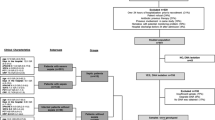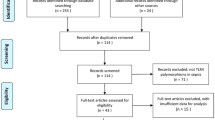Abstract
Many genetic variations have been identified to associate with sepsis in numerous studies, but the function of these variants in influencing sepsis is a complex process. We make use of mate-analysis and other analytic strategies (eQTL analysis and PPI network) to investigate the effect of interleukin-10 (IL10) on sepsis. Single-nucleotide polymorphisms (SNPs) in IL10 were analyzed in 3011 septic cases and 2976 controls from 22 studies. In results, the IL10-rs1800871 showed a significant association with sepsis in Asians (P < 0.05). Moreover, there is a association between rs1800896 and sepsis in pooled populations and Asians (P < 0.05). However, there is no association between rs1800872 and sepsis in different models. The three polymorphisms were also identified for the regulation of IL10 expression in an eQTL analyze, and the increased IL10 expression was related to the development of sepsis. Furthermore, the IL10 was discovered to associate with the expression of DRD1, TANK, MKL1, and STARD3NL genes in another independent cohort, which are functionally enriched for IRF3 (interferon regulatory factor 3)/IRF7 (interferon regulatory factor 7) and hormone pathways. In conclusion, the study confirmed the association between IL10 polymorphisms (rs1800871, rs1800872, rs1800896) and sepsis, and suggested the role of the variants in inflammatory pathologies.




Similar content being viewed by others
References
Abecasis GR, Altshuler D, Auton A et al (2010) A map of human genome variation from population-scale sequencing. Nature 467(7319):1061–1073
Balding J, Healy CM, Livingstone WJ et al (2003) Genomic polymorphic profiles in an Irish population with meningococcaemia: is it possible to predict severity and outcome of disease? Genes Immun 4(8):533–540
Cardoso CP, de Oliveira AJ, Botoni FA et al (2015) Interleukin-10 rs2227307 and CXCR2 rs1126579 polymorphisms modulate the predisposition to septic shock. Mem Inst Oswaldo Cruz 110(4):453–460
Carregaro F, Carta A, Cordeiro JA, Lobo SM, Silva EH, Leopoldino AM (2010) Polymorphisms IL10-819 and TLR-2 are potentially associated with sepsis in Brazilian patients. Mem Inst Oswaldo Cruz 105(5):649–656
Chen PG, Guan YJ, Zha GM et al (2017) Swine IRF3/IRF7 attenuates inflammatory responses through TLR4 signaling pathway. Oncotarget 8(37):61958–61968
Davis SM, Clark EA, Nelson LT, Silver RM (2010) The association of innate immune response gene polymorphisms and puerperal group A streptococcal sepsis. Am J Obstet Gynecol 202(3):308.e301-308
Dimas AS, Deutsch S, Stranger BE et al (2009) Common regulatory variation impacts gene expression in a cell type-dependent manner. Science 325(5945):1246–1250
Emonts M, Vermont CL, Houwing-Duistermaat JJ et al (2010) Polymorphisms in PARP, IL1B, IL4, IL10, C1INH, DEFB1, and DEFA4 in meningococcal disease in three populations. Shock 34(1):17–22
Garnacho-Montero J, Aldabo-Pallas T, Garnacho-Montero C et al (2006) Timing of adequate antibiotic therapy is a greater determinant of outcome than are TNF and IL-10 polymorphisms in patients with sepsis. Crit Care 10(4):R111
Gu W, Zeng L, Zhou J et al (2010) Clinical relevance of 13 cytokine gene polymorphisms in Chinese major trauma patients. Intensive Care Med 36(7):1261–1265
Gupta DL, Nagar PK, Kama VK, Bhoi S, Rao DN (2015) Clinical relevance of single nucleotide polymorphisms within the 13 cytokine genes in North Indian trauma hemorrhagic shock patients. Scand J Trauma Resusc Emerg Med 23:96
Handen A, Ganapathiraju MK (2015) LENS: web-based lens for enrichment and network studies of human proteins. BMC Med Genom 8(Suppl 4):S2
Hatesuer B, Hoang HT, Riese P et al (2017) Deletion of Irf3 and Irf7 genes in mice results in altered interferon pathway activation and granulocyte-dominated inflammatory responses to influenza A infection. J Innate Immun 9(2):145–161
Hugo Montes A, Valle-Garay E, Martin G et al (2021) The TNF-α (-238 G/A) polymorphism could protect against development of severe sepsis. Innate Immun 27(5):409–420
Jin X, Hu Z, Kang Y et al (2012) Association of IL-10-1082 G/G genotype with lower mortality of acute respiratory distress syndrome in a Chinese population. Mol Biol Rep 39(1):1–4
Lee SJ, Gharbi A, You JS et al (2019) Drug repositioning of TANK-binding kinase 1 inhibitor CYT387 as an alternative for the treatment of gram-negative bacterial sepsis. Int Immunopharmacol 73:482–490
Liu A, Ding S (2019) Anti-inflammatory effects of dopamine in lipopolysaccharide (LPS)-stimulated RAW264.7 cells via inhibiting NLRP3 inflammasome activation. Ann Clin Lab Sci 49(3):353–360
Liu AC, Patel K, Vunikili RD et al (2020) Sepsis in the era of data-driven medicine: personalizing risks, diagnoses, treatments and prognoses. Brief Bioinform 21(4):1182–1195
Lowe PR, Galley HF, Abdel-Fattah A, Webster NR (2003) Influence of interleukin-10 polymorphisms on interleukin-10 expression and survival in critically ill patients. Crit Care Med 31(1):34–38
Mao ZR, Zhang SL, Feng B (2017) Association of IL-10 (-819T/C, -592A/C and -1082A/G) and IL-6 -174G/C gene polymorphism and the risk of pneumonia-induced sepsis. Biomarkers 22(2):106–112
McDaniel DO, Hamilton J, Brock M et al (2007) Molecular analysis of inflammatory markers in trauma patients at risk of postinjury complications. J Trauma 63(1):147–157
Montoya-Ruiz C, Jaimes FA, Rugeles MT, López J, Bedoya G, Velilla PA (2016) Variants in LTA, TNF, IL1B and IL10 genes associated with the clinical course of sepsis. Immunol Res 64(5–6):1168–1178
Murray PJ (2006) Understanding and exploiting the endogenous interleukin-10/STAT3-mediated anti-inflammatory response. Curr Opin Pharmacol 6(4):379–386
Nakada TA, Hirasawa H, Oda S et al (2005) Influence of toll-like receptor 4, CD14, tumor necrosis factor, and interleukine-10 gene polymorphisms on clinical outcome in Japanese critically ill patients. J Surg Res 129(2):322–328
Namath A, Patterson AJ (2009) Genetic polymorphisms in sepsis. Crit Care Clin 25(4):835–856
O’Garra A, Barrat FJ, Castro AG, Vicari A, Hawrylowicz C (2008) Strategies for use of IL-10 or its antagonists in human disease. Immunol Rev 223:114–131
Okamura M, Shizu R, Abe T et al (2020) PXR functionally interacts with NF-κB and AP-1 to downregulate the inflammation-induced expression of chemokine CXCL2 in mice. Cells 9(10):2296
Pan W, Zhang AQ, Yue CL et al (2015) Association between interleukin-10 polymorphisms and sepsis: a meta-analysis. Epidemiol Infect 143(2):366–375
Peronnet E, Venet F, Maucort-Boulch D et al (2017) Association between mRNA expression of CD74 and IL10 and risk of ICU-acquired infections: a multicenter cohort study. Intensive Care Med 43(7):1013–1020
Prescott HC, Angus DC (2018) Postsepsis morbidity. JAMA 319(1):91
Reinhart K, Daniels R, Kissoon N, Machado FR, Schachter RD, Finfer S (2017) Recognizing sepsis as a global health priority: a WHO resolution. N Engl J Med 377(5):414–417
Saraiva M, O’Garra A (2010) The regulation of IL-10 production by immune cells. Nat Rev Immunol 10(3):170–181
Schaaf BM, Boehmke F, Esnaashari H et al (2003) Pneumococcal septic shock is associated with the interleukin-10-1082 gene promoter polymorphism. Am J Respir Crit Care Med 168(4):476–480
Shimada T, Oda S, Sadahiro T et al (2011) Outcome prediction in sepsis combined use of genetic polymorphisms: a study in Japanese population. Cytokine 54(1):79–84
Shu Q, Fang X, Chen Q, Stuber F (2003) IL-10 polymorphism is associated with increased incidence of severe sepsis. Chin Med J (engl) 116(11):1756–1759
Singer M, Deutschman CS, Seymour CW et al (2016) The third international consensus definitions for sepsis and septic shock (sepsis-3). JAMA 315(8):801–810
Sørensen TI, Nielsen GG, Andersen PK, Teasdale TW (1988) Genetic and environmental influences on premature death in adult adoptees. N Engl J Med 318(12):727–732
Stanilova SA, Miteva LD, Karakolev ZT, Stefanov CS (2006) Interleukin-10-1082 promoter polymorphism in association with cytokine production and sepsis susceptibility. Intensive Care Med 32(2):260–266
The International HapMap Project (2003) Nature 426(6968):789–796
Thomas Broome S, Louangaphay K et al (2020) Dopamine: an immune transmitter. Neural Regen Res 15(12):2173–2185
Vivas MC, Villamarín-Guerrero HF, Sanchez CA (2021) Interleukin-10 (IL-10) 1082 promoter polymorphisms and plasma IL-10 levels in patients with bacterial sepsis. Rom J Intern Med 59(1):50–57
Yong L, Peng D, Chen ZP, Lin JD (2018) Association of polymorphisms in IL-10 and the TLR4 signaling pathway with the development of postoperative sepsis. Int J Clin Exp Med 11(12):13501–13510
Yu L, Fang F, Dai X et al (2017) MKL1 defines the H3K4Me3 landscape for NF-κB dependent inflammatory response. Sci Rep 7(1):191
Zeng X, Zhang Y, Kwong JS et al (2015) The methodological quality assessment tools for preclinical and clinical studies, systematic review and meta-analysis, and clinical practice guideline: a systematic review. J Evid Based Med 8(1):2–10
Zhang DL, Zheng HM, Yu BJ, Jiang ZW, Li JS (2005) Association of polymorphisms of IL and CD14 genes with acute severe pancreatitis and septic shock. World J Gastroenterol 11(28):4409–4413
Zhu J, Hu Z, Han X et al (2018) Dopamine D2 receptor restricts astrocytic NLRP3 inflammasome activation via enhancing the interaction of β-arrestin2 and NLRP3. Cell Death Differ 25(11):2037–2049
Acknowledgements
The authors would like to thank all participants for their contribution to this study.
Funding
This study was supported by Nanjing Science and technology Development Project (YKK19133).
Author information
Authors and Affiliations
Contributions
NZ and WG wrote the main manuscript text. SW prepared figures 1-6. CS prepared Table 1. YF prepared supplement. All authors reviewed the manuscript.
Corresponding author
Ethics declarations
Competing Interests
The co-authors and corresponding authors declare that there is no conflict of interest in publishing this article.
Additional information
Publisher's Note
Springer Nature remains neutral with regard to jurisdictional claims in published maps and institutional affiliations.
Supplementary Information
Below is the link to the electronic supplementary material.
Rights and permissions
Springer Nature or its licensor (e.g. a society or other partner) holds exclusive rights to this article under a publishing agreement with the author(s) or other rightsholder(s); author self-archiving of the accepted manuscript version of this article is solely governed by the terms of such publishing agreement and applicable law.
About this article
Cite this article
Zhang, N., Wang, S., Fan, Y. et al. Association Between IL10 Polymorphisms and the Susceptibility to Sepsis: A Meta-Analysis. Biochem Genet 61, 847–860 (2023). https://doi.org/10.1007/s10528-022-10310-8
Received:
Accepted:
Published:
Issue Date:
DOI: https://doi.org/10.1007/s10528-022-10310-8




